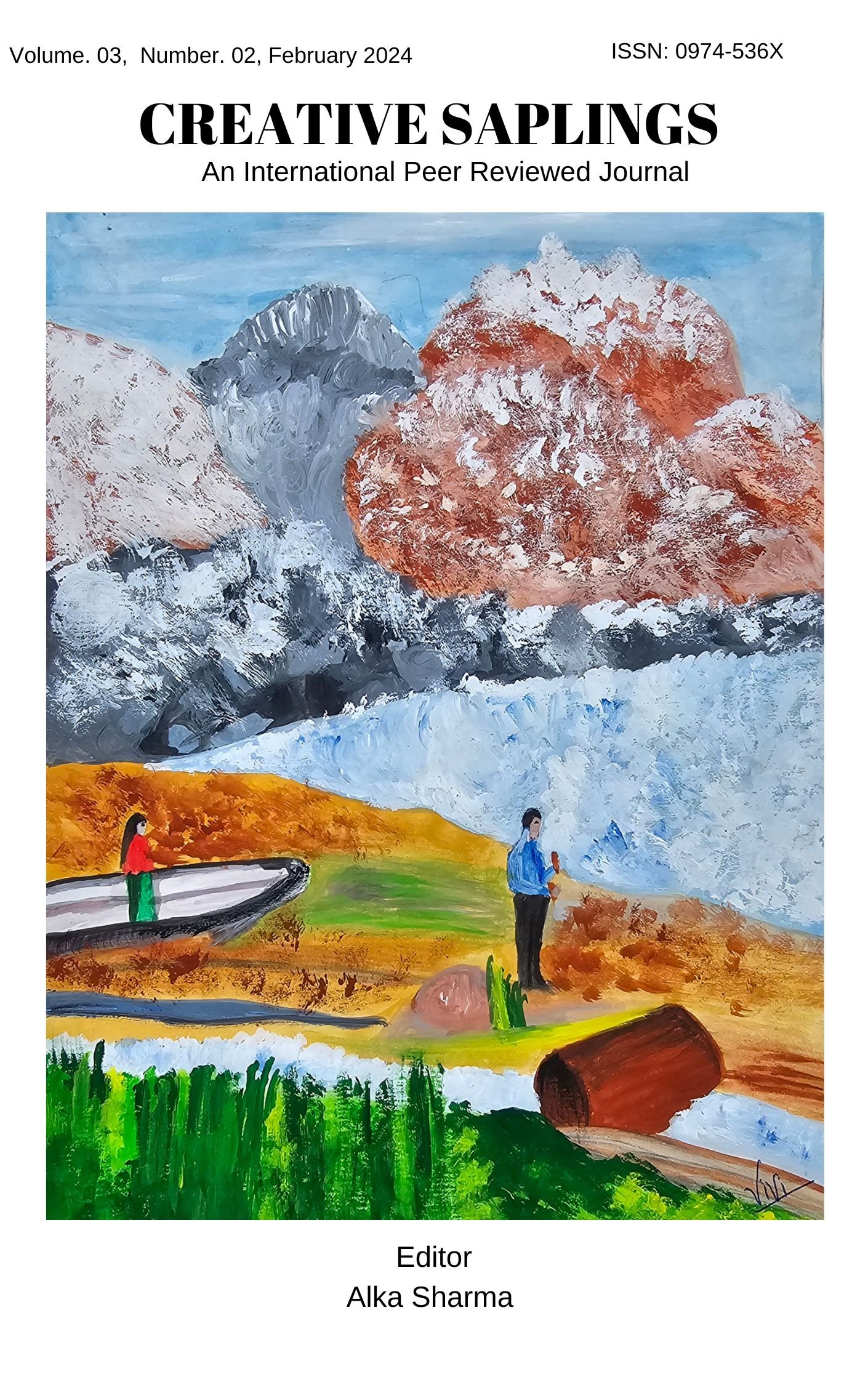Decoding the Migration, Rehabilitation, and the Impact of Caste in the Lives of Bengali Dalit Women Strata in the post-Partition Bengal: Revisiting Kalyani Thakur Charal’s Autobiographical Narrative Ami Keno Charal Likhi, and Novella Andhar Bil
DOI:
https://doi.org/10.56062/gtrs.2024.2.11.517Keywords:
Dalit, Bengali Dalit women, post-partition times, caste, gender, intersectionality, migration, rehabilitation.Abstract
Based on the reading of Kalyani Thakur Charal’s notable autobiographical narrative Ami Keno Charal Likhi (Why I Sign as Charal,2016) and novella Andhar Bil (2016), this paper intends to analyze the experiences of second-generation Bengali Dalit women refugees in case of the post-Partition West Bengal. The present paper examines the tropes of nostalgia, partition, and rehabilitation as experiences of Bengali Dalit women characters in the post-Partition West Bengal, the notions of migration, remembrance, oppression, and injustice. Through a detailed analysis of both the narratives, this research article intends to explore how the intersectional dynamism of caste, and gender have impacted the experiences of Bengali Dalit women strata substantially. In majoritarian aspects Bengali Dalit women characters have been reduced to mute objects, stripped of their agency, subjecthood, and desires, from which these two narratives shift substantially.
In case of the post-Partition scenario of West Bengal, the experiences of refugees from the different sections of the society are not a homogenized one. Kalyani Thakur’s narratives offer some valuable points for thinking about the differentiated experiences of migration, displacement, deprivation, and caste discrimination faced by Bengali Dalit women characters. Through her autobiographical narrative and the novella Andhar Bil, Kalyani Thakur also tries to portray how the intersectional dynamism of caste and gender has problematized the overall experiences of the Bengali Dalit populace in the post-Partition West Bengal. The researcher wants to argue that ideas like caste and gender both act as a site of oppression, which the grand narrative of the Bengal partition is primarily unable to capture. To develop this paper, the researcher consults literary, historical, and sociological facets of the Bengal Partition of 1947, Dalit identity, migration, and its effects on the Bengali Dalit population.
Downloads
References
Adji, Alberta Natasia. “From real life to story – and back again: using autobiographical fiction writing to understand self, others and family generations.” New Writing, 2023, pp. 1-12. https://doi.org/10.1080/14790726.2023.2187065.
Bandopadhyay, Atin. Nilkantho Pakhir Khonje. Calcutta: Karuna Prakashan, 1977.
Bandyopadhyay, Sekhar. “Partition and the ruptures in Dalit identity politics in Bengal.” Asian Studies Review, vol. 33, no. 4, 2009, pp. 455-467. https://doi.org/10.1080/10357820903363736.
Bandyopadhyay, Sekhar and Anasua Basu Ray Choudhury. “In Search of Space: The Scheduled Caste Movement in West Bengal after Partition.” Policies and Practices, no-59, 2014, pp.3-5. http://www.mcrg.ac.in/PP59.pdf .
Banerjee, Sarbani. “Different Identity Formations in Bengal Partition Narratives by Dalit Refugees.” Interventions International Journal of Postcolonial Studies, vol. 19, no. 4, 2017, pp. 551-553. https://doi.org/10.1080/1369801X.2016.1277154.
Bose, Pradip Kumar. “Memory begins where history ends.” Reflections on Partition of the East, edited by Ranabir Samaddar, Vikas Publishing House, 1997, pp. 73-86.
Bourdieu, Pierre. “The forms of capital.” J. Richardson (Ed.), Handbook of theory and research for the sociology of education, edited by J. Richardson, Greenwood, 1986, pp. 241–258.
Butalia, Urvashi. “Community, State and Gender: On Women’s Agency during Partition.” Economic and Political Weekly, vol. 28, no. 17, 1993, pp. WS12–24. JSTOR, http://www.jstor.org/stable/4399641.
Butalia, Urvashi. An Introduction. Urvashi Butalia, (ed.) Partition: The Long Shadow Penguin Books, 2015, (pp. i–xviii).
Charal, Kalyani. Ami Keno Charal Likhi. Chaturatha Duniya, 2016.
Charal, Kalyani. Andhar Bil. Zubaan, 2022.
Charal, Kalyani Thakur and Sayantan Dasgupta, editor. Dalit Lekhika: Women’s Writings From Bengal, 1st ed., Stree, 2020.
Chatterjee, Partha. “Partition and the mysterious disappearance of caste in Bengal.” The politics of caste in West Bengal, edited by Uday Chandra, et al., Routledge, 2016, pp. 83–102.
Gangopadhyay, Sunil. Arjun. Translated by Chitrita Banerjee-Abdullah. New York, NY: Viking Penguin, 1987.
Gangopadhyay, Sunil. East–West. Translated by Enakshi Chatterjee. New Delhi: Sahitya Akademi, 2000.
Ilaiah, Kancha. Why I am not a Hindu: A Sudra Critique of Hindutva Philosophy, Culture and Political Economy. Samya, 2008.
Jodhka, Surinder S., and Jules Naudet. The Oxford Handbook of Caste. Oxford University Press, 2023.
Kaur, Ravinder. “Narrative absence: An ‘untouchable’ account of partition migration.” Contributions to Indian Sociology, vol.42, no.2, 2008, pp.281–306. https://doi.org/10.1177/006996670804200204.
Lee, Joel. “Odor and order: How caste is inscribed in space and sensoria.” Comparative Studies of South Asia, Africa and the Middle East, vol.37, no. 3, 2017, pp.470–490. https://doi.org/10.1215/1089201x-4279188.
Maruskin, Joan M. “The Bible: The ultimate migration handbook.” Church and Society, vol. 95, no. 6, 2005, pp. 77-90. https://www.greatplainsumc.org/files/ministries/mj_bible_immigration_handbook.pdf.
Pan, Anandita. “Theorizing ‘Intersectional Standpoint’.” Mapping Dalit Feminism: Towards An Intersectional Standpoint, Sage Publications, 2021, pp. 21-40.
Patil, Smita M. “Revitalising Dalit Feminism: Towards Reflexive, Anti-Caste Agency of Mang and Mahar Women in Maharashtra.” Economic and Political Weekly, vol. 48, no. 18, 2013, pp. 37–43. JSTOR, http://www.jstor.org/stable/23527307.
Rao, Anupama. “Introduction: Caste, Gender, and Feminism.” Introduction. Gender and Caste. Ed. Anupama Rao. New Delhi: Kali for Women, 2005, pp.1-47.
Rege, Sharmila. “Dalit Women Talk Differently: A Critique of ‘Difference’ and Towards a Dalit Feminist Standpoint Position.” Economic and Political Weekly, vol. 33, no. 44, 1998, pp. WS39–46.
Roy, Dayabati. “Caste and Power: An Ethnography in West Bengal, India.” Modern Asian Studies, vol. 46, no. 4, 2012, pp. 947–74.
Sinha, Atreyee and Shuchi. “From Tattered Past to Triumphant Present: Weaving Partitioned Lives by a Dalit Girl-child in Kalyani Thakur Charal’s Novella Andhar Bil O Kicchu Manush.” Rupkatha Journal on Interdisciplinary Studies in Humanities, vol.14, no.4, 2022, pp. 2-3.
Downloads
Published
Issue
Section
License
Copyright (c) 2024 Debdatta Chakraborty, Sarbani Banerjee

This work is licensed under a Creative Commons Attribution-NonCommercial 4.0 International License.





